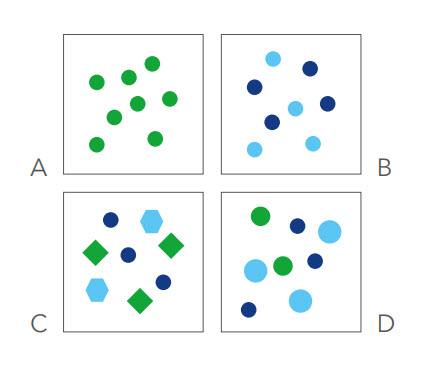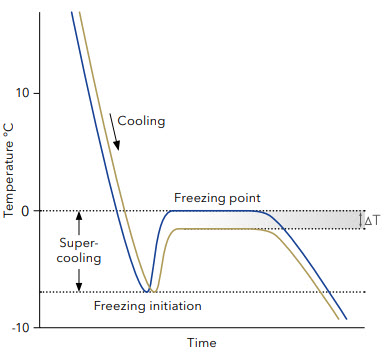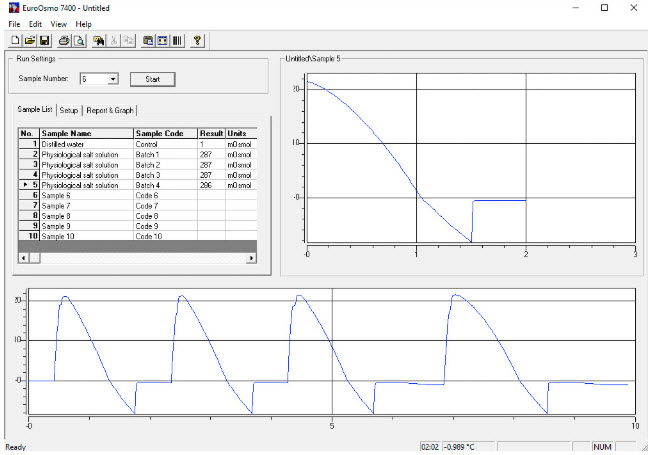KNAUER is one of the pioneers in the field of osmometry and is known for reliable and user-friendly osmometry instruments for many decades. In 1962 the company founder Dr. Herbert Knauer invented the company’s first freezing point osmometer. Since then the measurement technology has continuously adapted and advanced to meet the needs of the scientist. The latest development in this line of products is the K-7400S.
Based on proven KNAUER freezing point technology, the K-7400S features a small footprint, the robustness and silent operation of its popular predecessor, and has been improved significantly in specifications. The instrument is equipped with a Peltier cooler and an integrated microprocessor controlling the automated measurement. Through this, the K-7400S Semi-Micro Osmometer can determine the exact freezing point of aqueous solutions. The osmolality of various samples like pharmaceutical solutions or soft drinks can thus be easily determined.
Theory of Osmolality
Osmolality is a general measure of the particle concentration in a solute. It's not dependent on the nature of the molecules but only their number. Therefore, a two-molar solution of a non-dissociating molecule (A) has the same osmolality as a one-molar solution of a fully dissociating salt composed of two ions (B). The osmolality of a solution is the same, even when molecules vary in shape (C) as well as in size (D). Therefore, all solutions containing the same number of osmotically active particles — regardless of their chemical properties — exhibit the same osmolality.

The measurement principle of the K-7400S Semi-Micro Osmometer is based on the colligative property of freezing point depression. If a solute is added to a liquid this results in a decreased freezing point of the solution. The depression is 1.858° K. per 1 mole of ideally dissolved compound in one liter of water. This effect depends only on the number of particles in the liquid and not on the physical or chemical properties of the solutes. Due to this linear correlation, the osmolality of a sample can be determined by precisely measuring its freezing point.
Measuring Process
At the beginning of a measurement the sample is cooled by a microprocessor-controlled Peltier element. During this process, the solution is supercooled below 0°C while still being liquid. At a certain temperature the freezing process is initiated by a rotation of the stirring wire. The formation of ice crystals causes the release of thermal energy, thus rising the temperature of the sample. After a short period of time an equilibrium is reached where melting and thawing of ice crystals are balanced and the sample’s temperature stays constant. This plateau marks the real freezing point of the sample. During the whole process the temperature of the solution is measured by a high-precision thermistor. Thanks to a resolution of 1/1000° K. the freezing point temperature is exactly determined and even small differences in osmolality of two samples can be measured.

Applications of freezing point osmometry
Freezing point osmometry is a fast and reliable method to determine the osmolality of various solutions. In combination with the small sample size required and the simple measurement procedure it is a preferred method for laboratory analysis in industry and academia.
Quality Control of Pharmaceutical Solutions
The osmolality of solutions used in the clinical and pharmaceutical field is an important issue that requires regular monitoring. In particular, infusion solutions - but also solutions for external use like eye drops and rinsing solutions - have to be isotonic to ensure the physical well-being of the patient. Therefore, strict quality control is needed. The K-7400S allows a quick analysis of such solutions and provides reliable results even with small sample volumes. Thanks to the broad measurement range, high osmolality solutions can also be analyzed.

Analysis of isotonic drinks
Isotonic drinks are becoming more and more popular among professional and amateur athletes. Due to their special composition, nutrients and minerals in the drinks can be rapidly resorbed and thus replenish depleted amounts after strenuous physical activity. In contrast, non-isotonic drinks such as typical colas or beer need to be diluted in the intestine prior to adsorption. Thus, these beverages instead have a dehydrating effect. Since osmolality of the solution is the critical feature in this context, an exact test method is needed. The K-7400S Semi-Micro Osmometer is perfectly suited for this measurement, due to its independence of sample composition.

Therefore, drinks as diverse as sugared soft drinks, their sugar-free counterparts, as well as alcoholic and non-alcoholic beers - and many more - can easily be analyzed. This provides a fast and reliable method for both quality control and comparison of different drinks regarding their potential beneficial effects.
EuroOsmo 7400 Control Software
The K-7400S Semi-Micro Osmometer is a standalone device. Therefore, all functions of the instruments are accessible via the keypad.
For additional storage and data management functions, users can employ the EuroOsmo 7400 software. This software offers a user-friendly interface to control the K-7400S Semi-Micro Osmometer via PC.

Measurement parameters can easily be changed and sent to the instrument via the software. For each sample a temperature curve is displayed to visualize the measurement process. Samples can be named individually and the measurement results can be saved for archiving. The data can also be exported in different file formats (e.g. *.xls, ASCII or Tab-delimited text files). Thus, also the import to laboratory information management systems (LIMS) is possible. Supporting the use of a barcode scanner, sample identification can be transferred automatically, reducing the risk of wrong sample assignment.

